Figure 3.

Changes of bile duct histology and liver function. (a, b) HE staining showing intact bile duct morphology and continuous epithelium in the sham group, while continuity of bile duct epithelium was destroyed (red ellipse) and immunohistochemistry of CK19 showed occlusion of large intrahepatic bile duct in the NMP group (black arrow). In the BP and HBP groups, a large number of regenerative biliary cells (blue ellipse) were observed, and continuity of the bile duct epithelium was restored. (c) Liver function in each group 7 days after operation (n = 5). ALT, AST, GGT, and TBil in the sham group were 38.96 ± 5.09 U/L, 44.16 ± 7.67 U/L, 2.50 ± 0.70 U/L, and 1.28 ± 0.77 μmol/L, respectively, while those in the NMP group were significantly increased (248.80 ± 36.78 U/L, 375.30 ± 66.91 U/L, 82.56 ± 11.34 U/L, and 9.10 ± 1.90 μmol/L, respectively). Compared with the NMP group, the liver functions in the BP group (179.50 ± 21.42 U/L, 250.60 ± 44.92 U/L, 48.36 ± 9.21 U/L, and 4.92 ± 1.18 μmol/L, respectively) and HBP group (118.30 ± 16.95 U/L, 161.20 ± 18.98 U/L, 24.72 ± 7.54 U/L, and 2.74 ± 0.39 μmol/L, respectively) were improved significantly. CBD: common bile duct; IHBD: intrahepatic bile duct. ∗P < 0.05, ∗∗P < 0.01, ∗∗∗P < 0.001. HE: hematoxylin and eosin; CK19: cytokeratin 19; NMP: normothermic machine perfusion; HBP: HO-1/BMMSCs plus NMP; BP: BMMSCs plus NMP; ALT: alanine aminotransferase; AST: aspartate aminotransferase; GGT: gamma-glutamyl transpeptidase; TBil: total bilirubin.
